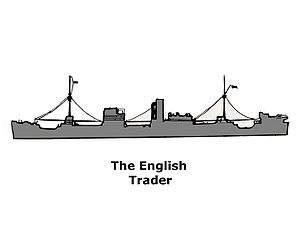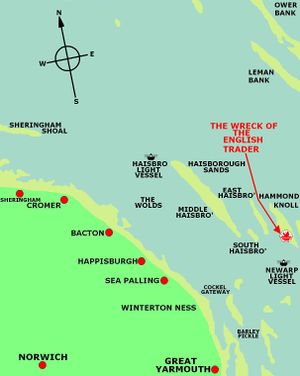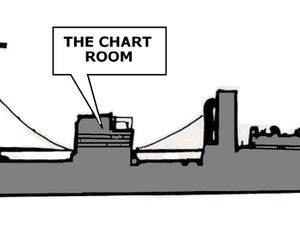SS English Trader
| 40px | To comply with Wikipedia's guidelines, the introduction of this article may need to be rewritten. Please discuss this issue on the talk page and read the layout guide to make sure the section will be inclusive of all essential details. (September 2009) |

| |
| Career (United Kingdom) | |
|---|---|
| Name: | SS Arches |
| Owner: | Arctees Shipping Company Ltd. |
| Ordered: | 1933 |
| Builder: | Furness Ship Building Company Ltd |
| Launched: | 1934 |
| Maiden voyage: | 1934 |
| Career (United Kingdom) | |
| Name: | SS English Trader |
| Owner: | Trader Navigation Company Ltd |
| Acquired: | 1936 |
| Out of service: | 24 October 1941 |
| Homeport: | London[1] |
| Identification: |
UK Official Number 163446[1] Code letters GWPT[1] 30x15px30x15px30x15px30x15px |
| Fate: | Ran aground on Hammond Knoll on the North Norfolk Coast |
| General characteristics | |
| Tonnage: | 3,953 GRT |
| Length: | 362 feet 5 inches (110.46 m)[1] |
| Beam: | 57 feet 5 inches (17.50 m)[1] |
| Installed power: | 357 horsepower (266 kW) nominal |
| Propulsion: |
Two single-ended boilers with a working pressure of 220lb psi. Triple expansion reciprocating steam engine (North East Marine Engineering Company Limited, Newcastle upon Tyne) 357 horsepower (266 kW)[1] Single propeller |
| Speed: | 8-10 knots |
| Crew: | 38 |
The SS English Trader was a merchant ship which was wrecked in 1941 off the coast of Norfolk, England on the Hammond's Knoll sandbank.[2]. Several epic rescue attempts by lifeboats failed, but a further attempt, the following day, by the Cromer lifeboat rescued the surviving 44 men on board.
The ship was built in 1934 [2] at the shipyards of the Furness Ship Building Company Ltd at Haverton-Hill-on-Tees for the Arctees Shipping Company Ltd[2] where she was then called Arches. She was designed by Joseph Isherwood and had the revolutionary "ARCFORM"[2] hull design to improve fuel consumption. Fifty ships were built to that design between 1933 and 1954. Joseph Isherwood later received a knighthood in recognition of his contribution to the maritime industry. In 1936 she was sold to the Trader Navigation Company Ltd as their first tramp vessel and renamed English Trader. All the company's later vessels had the same -Trader suffix.
Contents
Service
The first three years of the vessel's life were uneventful. On 23 January 1937 the English Trader found herself in the waters of the Devon coast. Whilst entering Dartmouth harbour she was run aground[2] close to the Castle at the entrance to the haven. Attempts were made to re-float her by four tugs and a Royal Navy destroyer without any success. She was badly holed and some of the holds were filling with debris and so after ten day of being stuck fast, drastic measures were taken to save the ship. This course of action involved cutting the ship in two at her bow section which was eventually scrapped. The process took nineteen days after which the undamaged after part was pulled stern-first into Dartmouth Harbour. Later she was moved to Southampton. A contract was given to The Middle Docks & Engineering Company of South Shields to repair her. She was rebuilt from the boiler room forward in only 100 days[2]. It is argued that the ships uncomfortable and pronounced roll of her future career were as a result of this grafting work.
The Second World War
From the start of the Second World War the English Trader played her part in fetching and carrying thousands of tons of cargo to and from the British Isles. For two years she crossed the seas avoiding U-Boats, mines and aircraft attacks. In October 1941 she was berthed in London Docks where a cargo of sugar from Cuba was being unloaded. By 23 October she had discharged her cargo and was taking aboard a mixed cargo bound for Mombasa, Kenya. The cargo contained a variety of export goods including farm tractors and other agricultural implements, umbrellas, pocket watches, whisky, Andrews Liver Salts, dresses and kitchenware. Stamped on the cases was proudly announced ‘BRITAIN DELIVERS THE GOODS’[2] in defiance of Hitler’s aggressive war against Britain.
Convoy EC90
Before her next voyage, a virtually new crew had been signed on - of the crew of 47, only eight men had been on the previous voyage[2]. This eight included Captain Grimstone and his three deck officers, the Mate John Elliot, William Hickson the Gun Layer, two other gunners and the ship steward. On Friday 24 October, in the early afternoon the English Trader left the Thames for what would be her last voyage. By late afternoon she had reached Southend on Sea. Here the Thames estuary was wide enough for convoys to form up in relative safety. Convoy EC90 was made up of 20 ocean-going freighters, two or three coastal steamers and two Royal Navy destroyers, one of which was the ageing HMS Vesper[2]. Convoy EC90 set of on its voyage in single file to start with, proceeding at a steady eight knots. For the English Trader this was close to her maximum speed; with a crew who knew how to get the best from her which the new crew did not. The convoy’s route would take it up the east coast of England and around the top of Scotland and down into the Atlantic Ocean. The English Channel was far too hazardous for shipping convoys at this stage of the War. By 3 p.m. the English Trader's troubles had begun. She had been running sluggishly, which had been noticed by the crew members from previous voyages. She was now a least a half a mile behind the bulk of the convoy and HMS Vesper was enquiring for the reasons for the poor speed of the ship. The Captain inquired with the chief engineer as to what the problem was, but to no avail. The speculation from the more experienced crew members was that the English Traders’ coal-fired boilers which were forced draught fed required the Booster fans to be precisely set. It was concurred that the ill-experienced new crew and the new chief engineer were unable to accomplish this. The captain was told by the commodore aboard the Vesper that if she could not regain her position in the convoy by nightfall she should make for harbour at one of the east coast ports.
Aircraft Attack
By nightfall the English Trader was some five miles from the convoy and at times laboured to achieve 4 knots. The crew were apprehensive; a lame duck, such as their predicament was, made easy pickings for enemy U-Boats and aircraft alike. The situation was made worse when in the darkness, the convoy ahead came under attack. The night sky lit up in a blaze of fire as the aerial attack commenced. The crew now prayed that they would not be spotted. Almost as suddenly as it had started the attack on the convoy stopped and again all around the English Trader became veiled in darkness. The next few moments were a terrifying experience for the crew as the ominous sound and shape of a Dornier Do 17 bomber attacking the ship[2]. The gunner aboard English Trader opened up at the approaching aircraft. The crew watched as the bomber released two bombs, which narrowly missed the ship. Two huge large pillars of white foam rose as high as her mast on the port side just yards from the ship. The bomber now swooped over the ship and into the darkness to prepare for another attack. Much to the surprise of the crew, HMS Vesper had broken off from the main convoy to help[2]. Vesper opened fire on the aircraft, possibly damaging it as it broke of it attack and was not seen again.
Aground on Hammond Knoll
By midnight all was quiet, but the ship was still labouring to rejoin the main part of the convoy. Steaming on slowly, Saturday turned into Sunday. Sunday 26 October[2] would be a day that the crew of the English Trader would never forget. Between 1 am and 1.30 am the ship was struggling against a strong ebbing tide, which in turn forced her dangerously close to the sandbanks of Hammond Knoll[2]. At around 1:45 am the crew felt a slight jolt followed by a more severe Jolt. This flung the ship forward followed by loud grinding, crunching and scraping of metal. Then there was silence. The ship had run aground on Hammond Knoll.
The English Trader was stranded on the knoll with her crew powerless to do anything about her. As the first signs of daylight approached the weather began to rapidly deteriorate, with the wind reaching gale force. Ever increasing waves crashed around her decks, smashing the starboard lifeboat and its derrick. The ship's back had broken as it settled on the knoll and the sea started it relentless destruction of the English Trader. The port lifeboat, though in the lee of the storm, could not be launched because of the turbulent waves crashing around the sandbank. The crew would rely on others for their rescue.
Lifeboat Launched
At 8.15 am the Cromer Lifeboat was launched and was asked to aid the English Trader. She was crewed by twelve men including the triple RNLI Gold Medal holding coxswain Henry Blogg. By 11.35 that morning the lifeboat, H F Bailey had reached Hammond Knoll. Unfortunately by this time three of the English Trader's crew had been swept off the foundering ship to their death. By the time the H F Bailey reached the ship the gale was at full force and things looked bleak. The remaining 44 crew of the stricken ship had taken refuge in the chart room, the highest and safest point on the ship. The Cromer lifeboat made two attempts to get a line to the English Trader with out any success. A further attempt at rescue resulted in a near disaster for the H F Bailey and in the death of one of her crew. Coxswain Henry Blogg had attempted to approach the stricken vessel and a wall of water hit the lifeboat on her port side which washed five of the lifeboat men, including the non-swimmer Blogg, overboard into the raging sea. The five men were hauled back on to the lifeboat but the signalman, Edward "Boy Primo" W Allen after being in the water for 25 minutes fell unconscious and died a short time later. At 3 pm the Cromer lifeboat broke off the rescue attempt and made for Great Yarmouth, her crew had tried in vain for seven long hours to rescue the crew of the English Trader and were now exhausted. Meanwhile The Great Yarmouth and Gorleston Lifeboat had been launched and was on its way. Between 4 and 6 pm, that lifeboat made five attempts to get alongside with a line without any success. After these attempts and with darkness setting in, Coxswain Charles Johnson and his crew also reluctantly returned to Great Yarmouth after receiving orders from the Royal Navy. By 8 am the next morning the Cromer Lifeboat was back at the Sands. The sea had calmed considerably by now and the H F Bailey was able to take the beleaguered crew of 44 from the English Trader with relative ease, taking them to the safety of Great Yarmouth. The English Trader was then left to her fate, stuck upon the sands of Hammond Knoll. Reports from the following day said that the English Trader had gone completely under the waves.
| Edward Walter Allen | |
|---|---|
|
200px Edward Walter Allen | |
| Died |
26 October 1941 Hammond Knoll of Haisborough |
| Occupation | Signalman of the Cromer lifeboat |
Cromer Lifeboat Crew
| The Cromer Lifeboat | ||
|---|---|---|
| H. F. Bailey | ||
| Name | Rank | |
| Henry G Blogg | Coxswain | |
| John J (Jack) Davies | Second Coxswain | |
| Henry W (Swank) Davies | Mechanic | |
| James W Davies | Assistant Mechanic | |
| Edward W (Boy Primo) Allen | Signalman | |
| William T (Captain) Davies | Bowman | |
| John J Davies, jnr | Crewman | |
| Sidney C (Kelly) Harrison | Crewman | |
| Henry T (Shrimp) Davies | Crewman | |
| William H (Pimpo) Davies | Crewman | |
| Robert C Davies | Crewman | |
| James R (Dick) Davies | Crewman | |
References
- ↑ 1.0 1.1 1.2 1.3 1.4 1.5 "LLOYD'S REGISTER, NAVIRES A VAPEUR ET A MOTEURS" (PDF). Plimsoll Ship Data. http://www.plimsollshipdata.org/pdffile.php?name=37b0281.pdf. Retrieved 30 December 2008.
- ↑ 2.00 2.01 2.02 2.03 2.04 2.05 2.06 2.07 2.08 2.09 2.10 2.11 2.12 The loss of the English Trader, By Cyril Jolly,Chapter 1, Page 1 ISBN 0906554063
- Jolly, Cyril (1981): The Loss of the English Trader Acorn Editions. ISBN 0-906554-06-3
- Jolly, Cyril "Henry Blogg, the Greatest of the Lifeboatmen", Pub: Poppyland Publishing, new edition 2002, ISBN 0-946148-59-7
- Leach, Nicholas & Russell, Paul,Cromer Lifeboats 1804-2004, Pub: Tempus Publishing, 2004, ISBN 0-7524-3197-8
- Tikus, Ayer (2004): The Ship-wrecks off North East Norfolk Pub: Ayer Tikus Publications, ISBN
External links
- The Cromer Lifeboat
- Cromer Lifeboat Station
- The Old Cromer Lifeboat Shed
- H F Bailey Lifeboat (National Register of Historic Vessels)
- Lifeboat Museum Gallery
- Pages using duplicate arguments in template calls
- Pages with broken file links
- Articles needing cleanup from September 2009
- Articles with invalid date parameter in template
- All pages needing cleanup
- Wikipedia introduction cleanup from September 2009
- Articles with hCards
- 1934 ships
- Steamships of the United Kingdom
- World War II merchant ships of the United Kingdom
- Maritime incidents in 1941
- World War II shipwrecks in the North Sea
- Shipwrecks off the coast of Norfolk
- Merchant ships of the United Kingdom


